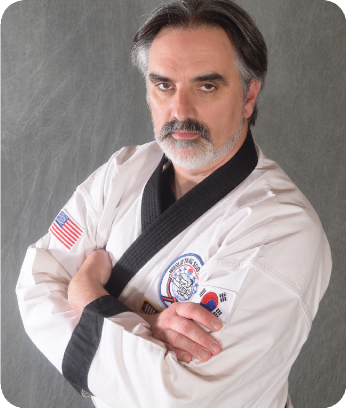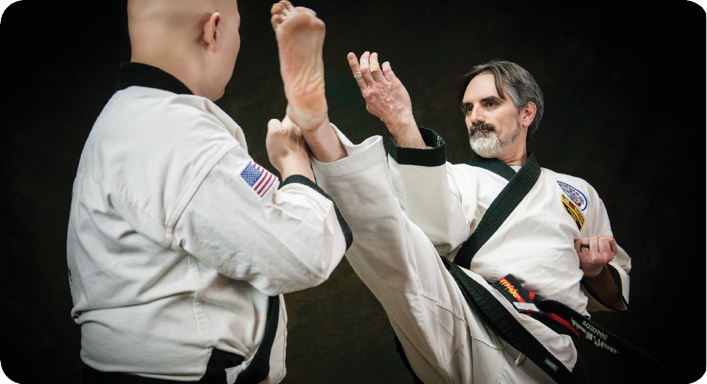By: Adam Theros
Most days start and end on the mat. New students always get a personal welcome—intro classes are something worth doing face-to-face. On the other end of the spectrum, the black belts and candidates come in for their advanced training. Classes run Monday through Saturday, and a strong team of instructors helps keep everything moving. Their development stays a priority that everyone teaches in line with our values.
 Time is regularly spent with beginners, helping to lay the foundation. A few days a week, it’s black belt training. Staying connected to all levels keeps everything in perspective. Fitting in personal training around a full teaching load is a unique challenge. With the World Tang Soo Do Association, there are regular chances to sharpen skills. Master Instructors gather yearly to refine techniques and share ideas, and quarterly regional training brings together martial artists from across Wisconsin, Illinois, Indiana, and Michigan.
Time is regularly spent with beginners, helping to lay the foundation. A few days a week, it’s black belt training. Staying connected to all levels keeps everything in perspective. Fitting in personal training around a full teaching load is a unique challenge. With the World Tang Soo Do Association, there are regular chances to sharpen skills. Master Instructors gather yearly to refine techniques and share ideas, and quarterly regional training brings together martial artists from across Wisconsin, Illinois, Indiana, and Michigan.
Local sessions with Chicagoland instructors add to that rhythm. Sometimes, joining a black belt class just to drill something specific makes all the difference. Other times, the school is quiet during the day—perfect for focused, solo work. Tang Soo Do remains a constant source of growth. Lately, there’s been a focus on breaking techniques down in new ways, helping students see the art from different angles. Classes follow a rotating curriculum, grouped by rank. This structure keeps the pace steady and the energy high, with each group receiving training tailored to their level.
Belt testing happens every three months for adults, every two for youth. The younger students progress through more belts, giving them a rhythm that fits their development. Evaluation weeks are scheduled in advance to make sure everyone is on track. To keep motivation high, students work toward earning Black Belt Character stripes—recognition not just for martial arts, but for schoolwork, acts of kindness, discipline, and even healthy eating habits.
It’s a way to build strong character, both inside and outside the studio. Those with a competitive spirit take part in monthly in-house tournaments, earning points toward trophies at the end of the season. The Holiday Banquet is always a crowd favorite, where awards are handed out and progress is celebrated.
Injury prevention is
built into everything. With age comes the need for more mindfulness, nutrition, warm-ups, and consistent training. Each class begins with dynamic movement, getting both mind and body ready to train. One class per week focuses purely on sparring. The rest rotate through core themes—forms, self-defense, and sparring drills—all aligned with the curriculum. A yearly training schedule helps students plan ahead and train with intention.
Tournament prep, test readiness, and curriculum retention are baked into the rhythm of classes. In- house tournaments provide regular performance opportunities and build confidence for events like Regional, National, and World Championships. Regular curriculum quizzes give students a chance to take ownership of their learning. The real reward comes from watching students grow. Families often walk in looking for help— more focus, confidence, and discipline. Watching those kids develop into leaders, watching them transform—that’s what makes it all worthwhile.
Running the business adds another layer. Teaching is only part of the job—there’s the front desk, finances, staffing, and programming. Weekly hours are long: classes from late afternoon through evening during the week, and mornings on Saturdays. Full-time staff meet weekly, instructors bi-weekly, and youth leaders train regularly. Events fill the calendar—Buddy Days, Parent Nights Out, weapons seminars, women’s self-defense classes, and monthly tournaments.
Community outreach is another cornerstone. Martial arts programs run through local park districts in two off-site locations. Booths, school seminars, and anti- bullying programs, staying involved is part of the mission. Even fundraisers have made an impact, like raising over $15,000 for St. Baldrick’s in honor of one of our students. Giving back stays at the heart of it all.
Health and wellness stay in front of mind. Teaching advanced classes often becomes a form of stress relief. Nutrition is a work in progress—progress over perfection. Mindfulness helps. Time off means leaving town completely—vacations are the only way to fully unplug. If the break isn’t taken somewhere else, work tends to follow. Two or three weeks a year of full disconnection brings the reset that’s needed.
Personal martial arts goals don’t get left behind. Being part of the World Tang Soo Do Association means continued learning and continued inspiration. Training with high-level martial artists across the world is a reminder to keep improving. Could a change be made? Earlier bedtimes. Late nights are a bad habit, and better sleep would make a huge difference. That’s the current personal challenge, one step at a time. Ultimately, it’s not just about mastering technique. It’s about helping others discover who they are through the discipline of martial arts. Each day brings new faces, new challenges, and new opportunities to lead by example. As the years go on, the mission remains unchanged: to teach, to grow, and to inspire. That’s the life of a master, lived one lesson at a time.

Master Adam Theros is a 5th Degree Black Belt in Tang Soo Do and the owner of Northwest Indiana Martial Arts Academy (NWIMAA) in Schererville, Indiana. He began training in 1993 and earned his black belt in 1998, later becoming a certified Master Instructor through the World Tang Soo Do Association in 2016. In 2013, he founded NWIMAA, now a thriving 7,000+ square foot facility serving over 200 students of all ages.
Master Theros is also a licensed Bully Expert, dedicated to creating a safe and empowering environment for his students. He serves as the Assistant Regional Director for WTSDA Region 5 and regularly leads community outreach programs, including youth martial arts classes in local parks. His entire family shares his passion—his wife and son are both black belts, and his daughter is actively training, continuing the tradition of martial arts excellence and family leadership.